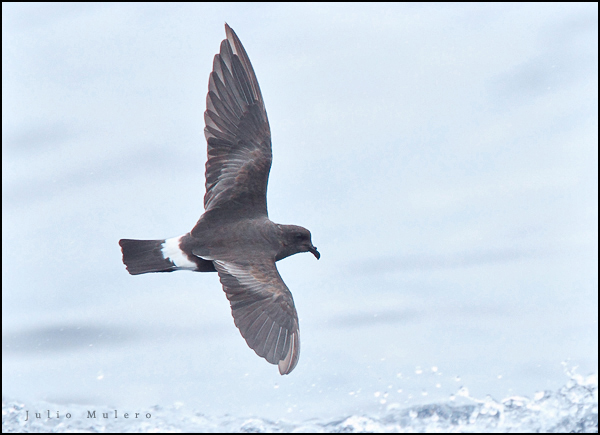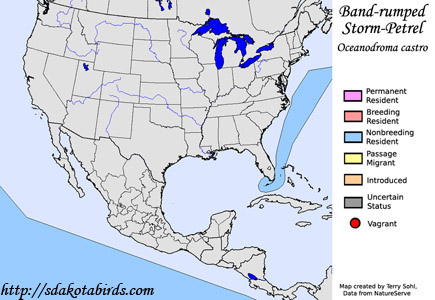| Length: 9 inches | Wingspan: 19 inches | Seasonality: Non-resident in South Dakota |
| ID Keys: Dark overall, obvious white rump, wedge-shaped tail with slight notch sometimes visible, relatively short tail | ||
 The
Band-rumped Storm-Petrel is a widely dispersed species with breeding
populations in both the Atlantic and Pacific Oceans. In North America,
they were only considered a rare vagrant, until the popularity of offshore
pelagic birding tours revealed that they are evidently regular visitors off
the Atlantic Coast. Given the remoteness of their breeding locations,
breeding behavior is poorly understood. However, it may be possible
that birds currently classified as Band-rumped Storm-Petrels may represent
two species, as "cold-season" and "warm-season" birds may both use the same
nesting areas at different times of the year. Vocalizations and behavior may
also be different between these two groups of birds.
The
Band-rumped Storm-Petrel is a widely dispersed species with breeding
populations in both the Atlantic and Pacific Oceans. In North America,
they were only considered a rare vagrant, until the popularity of offshore
pelagic birding tours revealed that they are evidently regular visitors off
the Atlantic Coast. Given the remoteness of their breeding locations,
breeding behavior is poorly understood. However, it may be possible
that birds currently classified as Band-rumped Storm-Petrels may represent
two species, as "cold-season" and "warm-season" birds may both use the same
nesting areas at different times of the year. Vocalizations and behavior may
also be different between these two groups of birds.
Habitat: Found on rocky island areas during the breeding season. Non-breeding birds are pelagic, rarely coming close to shore, and spending most of their time over warmer waters of the Atlantic and Pacific.
Diet: Feeds on small planktonic creatures, small fish, and small squid. They also are strongly attracted to the floating oils that often occur near cetacean carcasses.
Behavior: Forages by flying low or hovering over the water's surface, dipping down to grab prey items when they are spotted, often pattering their feet on the surface in typical Storm-Petrel fashion. They will also swim on the ocean's surface and pluck food items with their bill, or occasionally will make very shallow dives when pursuing prey. At nest sites, they are strictly nocturnal, as they fall prey to skua and gull species in parts of their range.
Nesting: The nest is a short burrow or a crevice in rocky ground. No nesting material is typically used, as the female lays her single egg directly on the ground. Both parents help to incubate the egg, and both parents help to raise the nestling after the egg hatches.
Interactive eBird Map: Click to access an interactive eBird map of Band-rumped Storm-petrel sightings
Song: Usually quiet away from nesting sites. On breeding grounds, makes a squeaky call followed by a low-pitched purring sound.
Migration: Breeding grounds are scattered island groups in tropical parts of both the Atlantic and Pacific Oceans, including islands off of western Europe and Africa, near Japan, Hawaii, and the Galapagos. Outside of the breeding season, disperses widely in warmer waters of the Atlantic and Pacific oceans.
Similar Species: In range, most likely to be confused with Wilson's Storm-Petrel, Leach's Storm-Petrel
Conservation Status: Populations of the species may be in decline, but they are still relatively common in parts of their range, and they are found over a wide geographic area. The IUCN lists the Band-rumped Storm-Petrel as a species of "Least Concern".
Further Information: 1) Audubon Guide - Band-rumped Storm-Petrel
2) Neotropical Birds from Cornell - Band-rumped Storm-Petrel
3) USGS Patuxent Bird Identification InfoCenter - Band-rumped Storm-Petrel
Photo Information: Photo taken by Julio Mulero- May 25th, 2012 - Off coast of North Carolina - Photo licensed under Creative Commons Attribution NonCommercial NoDerivs 2.0 Generic License
| Click below for a higher-resolution map |
 |
| South Dakota Status: Non-resident in South Dakota |
Additional Band-rumped Storm-Petrel Photos (coming soon!!)
